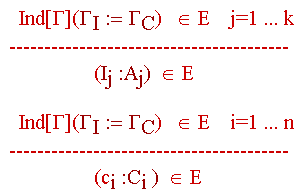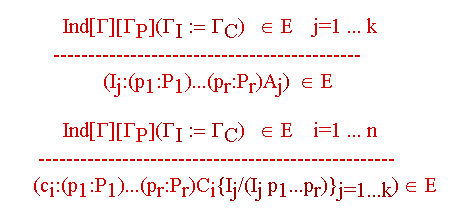Se escribe ![]() para
una definición inductiva válida en un contexto
para
una definición inductiva válida en un contexto ![]() ,
un
contexto de definiciones
,
un
contexto de definiciones ![]() ,
y
un contexto de constructores
,
y
un contexto de constructores![]() .
.
Conjunción: ![]()
naturales: ![]()
listas de elementos de A: ![]()
En general, ![]() ,
las reglas de tipado
,
las reglas de tipado
son:

Lo cual significa que si introducimos un tipo inductivo
en nuestro entorno E, quedan también incorporados al mismo el contexto
de definiciones y el de constructores.
Coq < Variables
A,B:Prop.
A is assumed
B is assumed
Coq < Inductive
and_AB:Prop := conj_AB:A->B->(and_AB).
and_AB_ind is defined
and_AB_rec is defined
and_AB is defined
Coq < Check and_AB.
and_AB
: Prop
Coq < Check conj_AB.
conj_AB
: A->B->and_AB
Pero cada definición inductiva incorpora también nuevos teoremas que implementan, por ejemplo, el proceso de prueba por inducción.
and_AB_ind is defined
and_AB_rec is defined
and_AB is defined
Coq < Check and_AB_ind.
and_AB_ind
: (P:Prop)(A->B->P)->and_AB->P
Esto significa, por ejemplo, que si tenemos que probar una proposición como and_AB->P, y tenemos una prueba H:and_AB, entonces basta que encontremos una prueba de (A->B->P)pues (and_AB_ind P)aplicado a dicha prueba nos proporciona una de nuestra proposición.
Este proceso constituirá la esencia de las tácticas de eliminación Elim H. Por ejemplo:
Coq < Lemma foo:and_AB
-> Propiedad.
1 subgoal
============================
and_AB->Propiedad
foo < Intro.
1 subgoal
H : and_AB
============================
Propiedad
foo < Elim H.
1 subgoal
H : and_AB
============================
A->B->Propiedad
foo <
Inductive nat
: Set := O : nat | S : nat->nat.
nat_ind
is defined
nat_rec
is defined
nat_rect
is defined
nat
is defined
Check
nat.
nat
: Set
Check
O.
O
: nat
Check
S.
S
: nat->nat
Check nat_ind.
nat_ind
: (P:nat->Prop)
(P O)->((n:nat)(P n)->(P (S n)))->(n:nat)(P n)
Por ejemplo:
Coq < Variable
predicado:nat -> Prop.
predicado is assumed
Coq < Lemma fooo:(n:nat)(predicado
n).
1 subgoal
============================
(n:nat)(predicado
n)
fooo < Intro.
1 subgoal
n : nat
============================
(predicado
n)
fooo < Elim n.
2 subgoals
n : nat
============================
(predicado
O)
subgoal 2 is:
(n:nat)(predicado
n)->(predicado (S n))
fooo <
Coq
< Variable A:Set.
A
is assumed
Coq
< Inductive List:Set:=nula:List|constr:A->List->List.
List_ind
is defined
List_rec
is defined
List_rect
is defined
List
is defined
Coq < Check nula.
nula
: List
Coq < Check constr.
constr
: A->List->List
Coq < Check List.
List
: Set
Coq < Variable
propiedad_listas:List -> Prop.
propiedad_listas
is assumed
Coq < Lemma
foooo:(l:List)(propiedad_listas l).
1 subgoal
============================
(l:List)(propiedad_listas
l)
foooo < Intro.
1 subgoal
l : List
============================
(propiedad_listas
l)
foooo < Elim l.
2 subgoals
l : List
============================
(propiedad_listas
nula)
subgoal 2 is:
(a:A)(l:List)(propiedad_listas
l)->(propiedad_listas (constr a l))
foooo <
Definiciones inductivas con parámetros:![]() significa
una definición inductiva válida en un contexto
significa
una definición inductiva válida en un contexto ![]() con parámetros
con parámetros ![]() ,
un contexto de definiciones
,
un contexto de definiciones ![]() y un contexto de constructores
y un contexto de constructores ![]() .
.
![]() está bien formado si y sólo si
está bien formado si y sólo si![]() lo
está.
lo
está.
Si![]() es
es![]() ,
un objeto en
,
un objeto en ![]() aplicado a
aplicado a
![]() se
comportará como el objeto correspondiente de
se
comportará como el objeto correspondiente de
Ind-Const

Coq
< Inductive and [A:Prop; B:Prop] : Prop := conj
: A->B->(and A B).
and_ind
is defined
and_rec
is defined
and
is defined
Coq < Print and_ind.
and_ind =
[A,B,P:Prop]
[f:A->B->P][a:(and A B)]Cases a of (conj x x0) => (f x x0) end
: (A,B,P:Prop)(A->B->P)->(and A B)->P
Coq < Print and_rec.
and_rec =
[A,B:Prop]
[P:Set][f:A->B->P][a:(and A B)]Cases a of (conj x x0) => (f x
x0) end
: (A,B:Prop)(P:Set)(A->B->P)->(and A B)->P
Coq
< Variable propiedad:Prop.
propiedad
is assumed
Coq
< Lemma Foo:(A,B:Prop)(A/\B)->propiedad.
1
subgoal
============================
(A,B:Prop)(and A B)->propiedad
Foo
< Intros.
1
subgoal
A : Prop
B : Prop
H : (and A B)
============================
propiedad
Foo
< Elim H.
1
subgoal
A : Prop
B : Prop
H : (and A B)
============================
A->B->propiedad
Foo
<
| DESTRUCTORES: Como se ve en el ejemplo anterior, los tipos inductivos
proveen un teorema (en este caso and_ind)
que nos permite eliminar (destructor) el tipo introducido. La idea es que
si queremos demostrar un cierto objetivo P, y tenemos una prueba H:(A/\B),
entonces Elim H nos da como subgoal (A->B->P), y ello porque aplicando
and_ind A B P:(A->B->P)->(A/\B)->P.
Lo análogo en el campo Set, sería and_rec. CONSTRUCTORES: Si se como objetivo G un tipo de dato construido por "constructores" C1,...,Cn (por ejemplo conj:A->B->(A/\B)), entonces Intros;Apply Ci equivale a Constructor ci. Suele tener nombres especiales. Por ejemplo, Apply conj = Split, Apply introl = Left o Apply intror=Right. En general la táctica Constructor i |
Se puede definir un tipo sin parámetros haciendo
declaraciones locales dentro de una section.
Cuando ésta se cierra se produce un proceso de generalización
que produce los mismos tipos en el entorno que si hubieramos definido el
tipo con parámetros.
Coq < Section
ejemplo.
Coq < Variables
A,B:Prop.
A is assumed
B is assumed
Coq < Inductive
and:Prop:=
Coq < conj:A->B->and.
and_ind is defined
and_rec is defined
and is defined
Coq < End ejemplo.
[Cooking #and_ind.cci]
[Cooking #and_rec.cci]
[Cooking #and_rec.fw]
Type and
: Prop->Prop->Prop
Constant and_ind
: (A,B,P:Prop)(A->B->P)->(and A B)->P
Constant and_rec
: (A,B:Prop)(P:Set)(A->B->P)->(and A B)->P
Coq < Check and.
and
: Prop->Prop->Prop
Coq < Check conj.
conj
: (A,B:Prop)A->B->(and A B)
Praeclarum
< Intros x y z t h; Elim h; Intros H' H'0; Clear h.
1
subgoal
x : Prop
y : Prop
z : Prop
t : Prop
H' : x->z
H'0 : y->t
============================
(and x y)->(and z t)
Praeclarum
< Intro h; Elim h; Intros H'1 H'2; Clear h.
1
subgoal
x : Prop
y : Prop
z : Prop
t : Prop
H' : x->z
H'0 : y->t
H'1 : x
H'2 : y
============================
(and z t)
Praeclarum
< Split.
2
subgoals
x : Prop
y : Prop
z : Prop
t : Prop
H' : x->z
H'0 : y->t
H'1 : x
H'2 : y
============================
z
subgoal
2 is:
t
Praeclarum
< Show 2.
subgoal 2 is:
x : Prop
y : Prop
z : Prop
t : Prop
H' :
x->z
H'0 :
y->t
H'1 :
x
H'2 :
y
============================
t
Praeclarum
< Apply H';Assumption.
1
subgoal
x : Prop
y : Prop
z : Prop
t : Prop
H' : x->z
H'0 : y->t
H'1 : x
H'2 : y
============================
t
Praeclarum
< Apply H'0;Assumption.
Subtree
proved!
Praeclarum
< Qed.
(Intros
x y z t h; Elim h; Intros H' H'0; Clear h).
(Intro
h; Elim h; Intros H'1 H'2; Clear h).
Split.
(Apply
H'; Assumption).
(Apply H'0; Assumption).
Praeclarum
is defined
Coq
< Print Praeclarum.
Praeclarum =
[x,y,z,t:Prop]
[h:(and
x->z y->t)]
(and_ind
x->z y->t (and x y)->(and z t)
[H':x->z]
[H'0:y->t]
[h0:(and x y)]
(and_ind x y (and z t)
[H'1:x][H'2:y](conj z t (H' H'1) (H'0
H'2)) h0) h)
: (x,y,z,t:Prop)(and x->z y->t)->(and x y)->(and
z t)
Inductive
List [A:Set]:Set :=
Nil:(List
A)|Cons:A->(List A)->(List A).
List_ind
is defined
List_rec
is defined
List_rect
is defined
List
is defined
Check Nil.
Nil
: (A:Set)(List A)
Check Cons.
Cons
: (A:Set)A->(List A)->(List A)
Check List.
List
: Set->Set
Coq < Inductive
Long [A:Set]: (List A)->nat->Prop :=
Lnil:(Long A (Nil A) O)
| Lcons : (a:A)(l:(List A)) (n:nat) (Long A l n)->(Long A (Cons A a l)
(S n)).
Long_ind is defined
Long is defined
Coq < Check Long.
Long
: (A:Set)(List A)->nat->Prop
Coq < Check Lnil.
Lnil
: (A:Set)(Long A (Nil A) O)
Coq < Check Lcons.
Lcons
: (A:Set)
(a:A)
(l:(List A))(n:nat)(Long A l n)->(Long A (Cons A a l) (S n))
La definición del cuantificador universal es un ejemplo de definición. No es un tipo inductivo.
Coq < Definition
all := [A:Set][P:A->Prop](x:A)(P x).
all is defined
El cuantificador Existencial sí es inductivo.
Coq < Inductive
ex [A:Set;P:A->Prop] : Prop := ex_intro : (x:A)(P x)->(ex A P).
ex_ind is defined
ex is defined
Coq < Check ex_ind.
ex_ind
: (A:Set)(P:A->Prop)(P0:Prop)((x:A)(P x)->P0)->(ex A P)->P0
Coq < Inductive
ex2 [A:Set;P,Q:A->Prop] : Prop := ex_intro2 : (x:A)(P x)->(Q x)->(ex2 A
P Q).
ex2_ind is defined
ex2 is defined
Coq < Check ex2_ind.
ex2_ind
: (A:Set)
(P,Q:A->Prop)(P0:Prop)((x:A)(P x)->
(Q x)->P0)->(ex2 A P Q)->P0
Se permiten las siguientes abreviaturas:
| (ALL x:A | P) | (all A [x:A]P) |
| (ALL x | P) | (all A [x:A]P) |
| (EX x:A | P) | (ex A [x:A]P) |
| (EX x | P) | (ex A [x:A]P) |
| (EX x:A | P & Q) | (ex2 A [x:A]P [x:A]Q) |
| (EX x | P & Q) | (ex2 A [x:A]P [x:A]Q) |
Hay cuantificador Existencial en el dominio Set
Inductive sig [A:Set; P:A->Prop] :
Set :=
exist
: (x:A)(P x)->(sig A P)
que se escribe {x:A | (P x)}